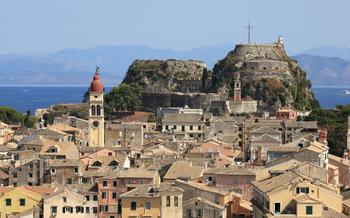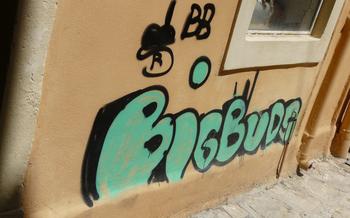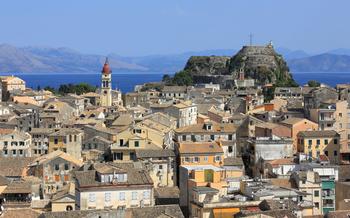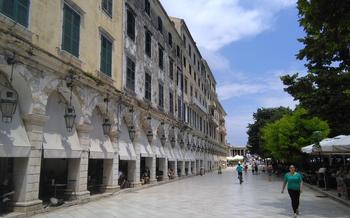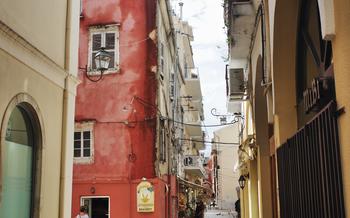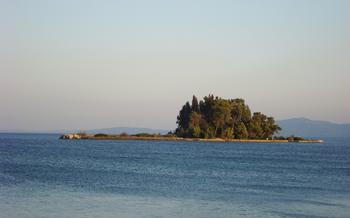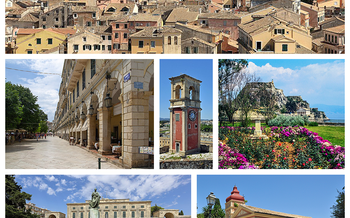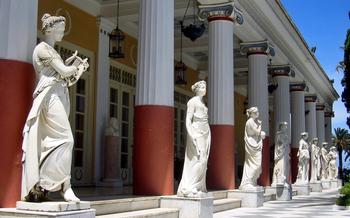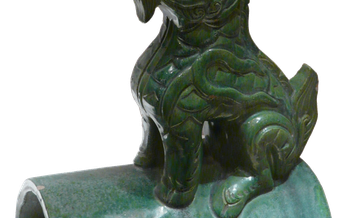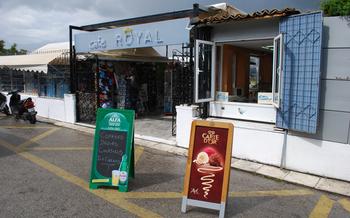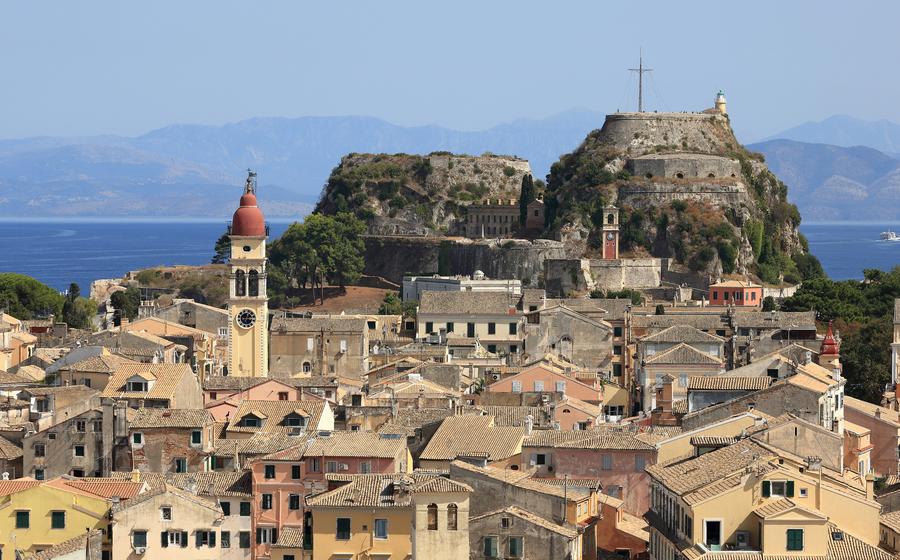
New Fortress of Corfu
- The Venetian Fortress: A Majestic Entrance to Corfu's History
- Exploring the Fortress: A Journey Through Time
- The Corfu Museum of Asian Art: A Hidden Gem Within the Fortress
- The Soldiers' Club: A Touch of British History
- The Church of Saint George: A Sacred Space Within the Fortress
- The Venetian Arsenal: A Glimpse into Maritime History
- The Corfu Cricket Ground: A Legacy of British Influence
- The Liston: A Lively Promenade with Venetian Charm
- The Old Town: A Labyrinth of History and Culture
- Corfu Palace: A Symbol of Venetian Power
- The Kanoni Viewpoint: A Breathtaking Panorama
- The Monastery of Paleokastritsa: A Spiritual Retreat
- The Achilleion Palace: A Glimpse into Sissi's World
- Insider Tip: Explore Corfu Like a Local
The Venetian Fortress: A Majestic Entrance to Corfu's History
The New Fortress of Corfu, a majestic sentinel guarding the entrance to the city's harbor, stands as a testament to Corfu's rich and storied past. Built by the Venetians in the 16th century as a defense against Ottoman invasions, this formidable fortress played a crucial role in safeguarding the island's independence. Its imposing walls and intricate fortifications, designed by renowned military engineers, showcase the ingenuity and resilience of the Venetian Republic.
As you approach the fortress, its sheer size and grandeur are awe-inspiring. The entrance gate, adorned with the Lion of Saint Mark, the symbol of Venetian power, invites you to step back in time and explore the fortress's fascinating history. Within its walls, you'll discover a labyrinth of ramparts, dungeons, and secret passages, each whispering tales of battles fought and triumphs celebrated.
One of the most captivating stories associated with the fortress is the legend of the "Mouse Hole." According to local lore, during a fierce Ottoman siege, the Venetians managed to repel the invaders by pouring boiling oil and pitch through a small hole in the fortress wall, effectively blocking the enemy's advance. This ingenious tactic, coupled with the fortress's impenetrable defenses, earned it the nickname "The Mouse Hole," symbolizing the Venetians' unwavering determination to protect their island.
Practical Information:
- Entrance Fees: General admission tickets cost around €6, with discounts for students and seniors.
- Visiting Hours: The fortress is open to the public daily from 8:00 AM to 8:00 PM during the summer months and from 8:00 AM to 6:00 PM during the winter months.
- Guided Tours: Guided tours in English and other languages are available for a small additional fee.
Exploring the Fortress: A Journey Through Time
Step through the fortress gates and embark on a journey through time as you explore its many fascinating nooks and crannies. Begin by tracing the perimeter, marveling at the towering ramparts that once protected the city from invaders. Imagine the fierce battles fought here, the thunder of cannons, and the cries of soldiers echoing through the air.
Descend into the depths of the fortress, where dark and mysterious dungeons await. These grim chambers once held prisoners of war and political dissidents, their stories lost to time. As you explore these subterranean spaces, feel the chill of history brush against your skin, and let your imagination run wild.
Discover secret passages, hidden behind unassuming doors or beneath loose floorboards. These secret routes were once used by soldiers to move undetected within the fortress, or by prisoners seeking a desperate escape. Follow their footsteps and feel the thrill of uncovering hidden secrets.
Ascend to the fortress walls and be rewarded with breathtaking panoramic views. Gaze out over the terracotta rooftops of Corfu Town, the sparkling Ionian Sea stretching to the horizon, and the distant peaks of mainland Greece. Let the beauty of the landscape wash away the echoes of the past and transport you to a place of serenity and tranquility.
During your exploration, keep an eye out for archaeological discoveries and excavations. The fortress grounds have yielded a wealth of artifacts and ruins, shedding light on the rich history of this place. From ancient pottery shards to remnants of Byzantine churches, each discovery adds another layer to the complex narrative of the New Fortress of Corfu.
Finally, let the local legends and myths surrounding the fortress ignite your imagination. Listen to tales of ghosts and apparitions that haunt the ramparts, or stories of hidden treasures buried beneath the fortress grounds. These legends add an air of mystery and intrigue to your visit, making it an unforgettable experience.
The Corfu Museum of Asian Art: A Hidden Gem Within the Fortress
Tucked away within the ramparts of the New Fortress lies a treasure trove of Asian art and artifacts—the Corfu Museum of Asian Art. This unique museum is a testament to the island's rich history as a crossroads of cultures and civilizations.
The museum's collection spans a vast array of Asian countries and regions, from China and Japan to Southeast Asia. Highlights include intricate Chinese porcelain, delicate Japanese prints, and finely carved Southeast Asian sculptures. Visitors can admire the exquisite craftsmanship and artistry of these objects, which offer a glimpse into the diverse cultures of Asia.
In addition to its permanent collection, the museum also hosts temporary exhibitions and cultural events throughout the year. These events provide an opportunity to delve deeper into specific aspects of Asian art and culture, such as traditional painting techniques or the history of Chinese calligraphy.
For a truly immersive experience, plan your visit to coincide with one of the museum's special events or workshops. These events offer a unique chance to learn from experts in Asian art and culture, and to engage with the museum's collection in a hands-on way. Whether you're an art enthusiast or simply curious about Asian culture, the Corfu Museum of Asian Art is a must-visit destination for anyone exploring the New Fortress.
The Soldiers' Club: A Touch of British History
Historical Background During the British rule of Corfu, which lasted from 1815 to 1864, the Soldiers' Club was established as a social and recreational center for British officers and their families. The club played a significant role in the social life of the British community on the island and served as a hub for various cultural and sporting activities.
Architectural Features The Soldiers' Club building is a striking example of British colonial architecture. It features a symmetrical facade with arched windows and a central portico supported by Doric columns. The interior of the club is equally impressive, with elegant rooms adorned with chandeliers, marble fireplaces, and intricate plasterwork.
Cultural Events Today, the Soldiers' Club continues to serve as a vibrant cultural center in Corfu. It hosts a variety of events throughout the year, including concerts, exhibitions, and lectures. The club also has a well-stocked library and a billiards room, providing visitors with a range of entertainment options.
Anecdotes and Stories One of the most famous stories associated with the Soldiers' Club is that of Gerald Durrell, the renowned British naturalist and author. Durrell spent several years on Corfu in the 1930s and was a frequent visitor to the club. In his book "My Family and Other Animals," Durrell vividly describes the club's lively atmosphere and the eccentric characters he encountered there.
The Church of Saint George: A Sacred Space Within the Fortress
Within the walls of the New Fortress of Corfu, stands the Church of Saint George, a testament to the spiritual lives of those who inhabited this bastion. Built in the 17th century, the church holds a significant place in the religious history of the fortress and the city itself. Its unassuming exterior conceals a wealth of artwork and architectural features that reflect the rich cultural heritage of Corfu.
Ornate iconography adorns the interior of the church, depicting scenes from the life of Saint George, the patron saint of soldiers and travelers. The intricate carvings and frescoes that grace the walls and ceiling showcase the talent of local artisans and the devotion of the community. The church also houses a collection of religious artifacts and relics, including a silver reliquary containing a fragment of Saint George's skull, which draws pilgrims from near and far.
Local traditions and festivals associated with the Church of Saint George are deeply rooted in the cultural fabric of Corfu. On Saint George's Day, celebrated annually on April 23rd, the church becomes the focal point of a vibrant procession. Believers gather to honor the saint, carrying his icon through the streets of the Old Town, accompanied by music and traditional dances. The church also hosts regular services and religious ceremonies, offering visitors a glimpse into the spiritual practices of the local community.
Insider Tip: For a truly immersive experience, attend a traditional Greek Orthodox service at the Church of Saint George. Immerse yourself in the melodious chanting, the fragrant incense, and the devout atmosphere as the community comes together to celebrate their faith. This is an exceptional opportunity to gain insights into the religious traditions and beliefs that shape the identity of Corfu.
The Venetian Arsenal: A Glimpse into Maritime History
The Venetian Arsenal, located within the New Fortress of Corfu, stands as a testament to the city's rich maritime history. Constructed in the 16th century, this impressive structure once served as a vital shipbuilding and repair facility for the Venetian navy, playing a crucial role in maintaining Corfu's naval dominance in the Mediterranean.
The arsenal's architectural features and design elements reflect its functional purpose. Its massive stone walls and vaulted ceilings provided a secure and efficient workspace for shipbuilders and artisans. Inside, visitors can still admire the original slipways, where ships were constructed and launched into the sea.
Today, the Venetian Arsenal houses a fascinating maritime museum, showcasing the history of shipbuilding and maritime trade in Corfu. Exhibits and displays bring to life the stories of the skilled craftsmen and sailors who worked within these walls, as well as the technological innovations that shaped Corfu's maritime prowess.
Insider tip: Look out for special events or demonstrations related to traditional boat-building techniques, often held at the arsenal. These events provide a unique opportunity to learn about the intricate skills and craftsmanship that went into building and maintaining wooden sailing ships.
The Corfu Cricket Ground: A Legacy of British Influence
The Corfu Cricket Ground stands as a testament to the enduring legacy of British influence on the island. Established in the 19th century by the British, this historic ground holds the distinction of being one of the oldest cricket grounds outside of the United Kingdom.
Cricket, a sport deeply ingrained in British culture, found its way to Corfu during the British protectorate of the Ionian Islands from 1815 to 186The British officers stationed on the island introduced the game to the locals, and soon, a passionate cricket community emerged.
The Corfu Cricket Ground became the focal point of this cricketing fervor. Nestled in the picturesque surroundings of the island, the ground exudes an old-world charm, with its lush green outfield and quaint pavilion. It has hosted countless matches over the years, including local tournaments and friendly games between British and Greek teams.
Today, the Corfu Cricket Ground continues to be a vibrant hub for cricket enthusiasts. Local teams compete regularly, keeping the spirit of the game alive. Visitors are welcome to catch a match and experience the unique atmosphere of this historic ground.
Insider tip: If you're lucky, you might catch a game of cricket and experience this unique British tradition in Corfu. Check with the local cricket club for match schedules and information on how to attend.
The Liston: A Lively Promenade with Venetian Charm
The Liston is a captivating promenade located in the heart of Corfu Town. Built by the French during their brief occupation of the island in the late 18th century, the Liston exudes an enchanting blend of Venetian and French influences. Its elegant arcaded walkways, adorned with intricate columns and arches, create a picturesque setting that transports visitors back in time.
Strolling along the Liston, one can't help but admire the architectural details that grace its buildings. The pastel-colored facades, adorned with wrought-iron balconies and decorative cornices, evoke a sense of grandeur and sophistication. The Liston is lined with a variety of cafes, restaurants, and shops, inviting visitors to indulge in culinary delights, browse for souvenirs, or simply soak up the lively atmosphere.
As the sun begins to set, the Liston transforms into a vibrant social hub. Locals and tourists alike gather at the outdoor tables of the cafes, sipping on refreshing beverages and engaging in lively conversations. The air fills with the sounds of laughter, music, and the clinking of glasses, creating a convivial ambiance that epitomizes the carefree spirit of Corfu.
Whether you're seeking a leisurely coffee break, a romantic dinner, or a night of lively entertainment, the Liston is the perfect place to immerse yourself in the vibrant energy of Corfu Town. As you stroll along this iconic promenade, let the charm of its Venetian and French heritage captivate your senses and create lasting memories of your Corfu experience.
Insider tip: Enjoy a leisurely coffee or a glass of wine at one of the Liston's cafes while watching the world go by. As the sun sets, the promenade transforms into a vibrant social hub, offering a lively atmosphere and a chance to soak up the true essence of Corfu's nightlife.
The Old Town: A Labyrinth of History and Culture
The Old Town of Corfu, a UNESCO World Heritage Site, is a captivating maze of narrow cobblestone streets, Venetian mansions, and historic churches that transport you back in time. Stroll through this atmospheric neighborhood and discover hidden gems around every corner. Admire the elegant architecture of the mansions, with their wrought-iron balconies and colorful facades. Visit the Church of Our Lady of the Angels, with its stunning 18th-century bell tower, or the Church of St. Spyridon, the patron saint of Corfu.
Immerse yourself in the local culture by visiting the shops, boutiques, and art galleries showcasing traditional crafts and products. Pick up a unique souvenir, such as a piece of handmade pottery or a bottle of local olive oil. Take a break at one of the many tavernas or cafes, and savor the flavors of Corfu's delicious cuisine.
Don't miss the opportunity to explore the Old Fortress, a Venetian masterpiece that guarded the city for centuries. Wander along the ramparts, marvel at the intricate fortifications, and enjoy breathtaking views of the sea. As you explore the Old Town, let your curiosity guide you. Get lost in the maze-like streets, uncover hidden courtyards, and soak up the charm of this historic gem.
Corfu Palace: A Symbol of Venetian Power
Standing as a testament to Venetian rule in Corfu, the Corfu Palace holds a prominent place in the city's history. Built in the 15th century, the palace served as the administrative center of the Venetian government and was a symbol of their power and influence on the island.
Its imposing structure, characterized by Venetian Renaissance architectural elements, reflects the grandeur and prestige of the Venetian Republic. The palace features intricate stone carvings, elegant balconies, and a majestic courtyard that once hosted lavish receptions and official ceremonies.
Today, the Corfu Palace continues to play a significant role, serving as the seat of the Ionian Parliament, the regional government of the Ionian Islands. Visitors can embark on guided tours of the palace to admire its well-preserved interiors, learn about its fascinating history, and gain insights into the Venetian era that shaped Corfu's identity.
The Kanoni Viewpoint: A Breathtaking Panorama
Perched atop a hill overlooking the Ionian Sea, the Kanoni Viewpoint offers visitors a breathtaking panorama that will leave them in awe. From this vantage point, you can feast your eyes on the Old Town of Corfu, with its Venetian architecture and colorful buildings, and the New Fortress, standing guard at the entrance to the harbor. The islet of Pontikonisi, also known as Mouse Island, adds a touch of enchantment to the scene, with its tiny church and cypress trees.
Legend has it that Pontikonisi is the petrified remains of Odysseus' ship, turned to stone by Poseidon, the god of the sea, as punishment for blinding his son, the Cyclops Polyphemus. According to another myth, the island was created by the Phaeacians, who used it as a ship to transport Odysseus back to Ithaca after his long and perilous journey.
The Kanoni Viewpoint is also a popular spot for watching the sunset, as the sky transforms into a canvas of vibrant colors, casting a golden glow over the Old Fortress and the surrounding landscape. Whether you're a photography enthusiast, a nature lover, or simply someone who appreciates breathtaking scenery, the Kanoni Viewpoint is a must-visit in Corfu.
Insider tip: Visit the viewpoint at sunset to witness a spectacular display of colors over the Ionian Sea.
The Monastery of Paleokastritsa: A Spiritual Retreat
Nestled amidst the picturesque village of Paleokastritsa on the northwestern coast of Corfu, the Monastery of Paleokastritsa stands as a testament to the island's rich religious and cultural heritage. Founded in the 13th century by a group of Byzantine monks seeking refuge from the turmoil of the mainland, the monastery has endured centuries of invasions and occupations, emerging as a beacon of faith and resilience.
The monastery's architectural features and design elements reflect its Byzantine origins, with intricate frescoes adorning the walls of its main church. The church is dedicated to the Virgin Mary, and its interior is adorned with stunning icons, offering a glimpse into the monastery's deep devotion to the Mother of God.
Perched on a cliff overlooking the turquoise waters of the Ionian Sea, the Monastery of Paleokastritsa offers breathtaking views of the surrounding landscape. The monastery's tranquil gardens, with their fragrant flowers and lush greenery, provide a serene retreat for visitors seeking respite from the hustle and bustle of modern life.
Beyond its religious significance, the Monastery of Paleokastritsa is also a cultural treasure trove. The monastery's museum houses a collection of artifacts, including ancient manuscripts, religious relics, and traditional costumes, offering visitors a glimpse into the monastery's past and the island's rich cultural heritage.
Insider Tip: Combine your visit to the monastery with a swim in the crystal-clear waters of Paleokastritsa beach, renowned for its stunning beauty and ideal swimming conditions. The beach is located just a short walk from the monastery, making it the perfect place to cool off and relax after exploring this sacred site.
The Achilleion Palace: A Glimpse into Sissi's World
Nestled amidst lush gardens on the outskirts of Corfu Town, the Achilleion Palace stands as a testament to the grandeur and eccentricity of Empress Elisabeth of Austria, also known as Sissi. Built between 1889 and 1891, this magnificent palace was Sissi's summer retreat, where she sought solace and inspiration away from the confines of the Habsburg court.
Architecturally, the palace is a masterpiece of Neoclassical design, drawing inspiration from Greek mythology and classical architecture. Its white marble facade is adorned with intricate carvings, statues, and friezes depicting scenes from Greek mythology. Inside, the palace is a treasure trove of artwork, including paintings, sculptures, and tapestries that reflect Sissi's love of art and culture.
One of the highlights of the palace is the Achilleion Museum, which houses a collection of personal belongings and memorabilia that belonged to Sissi. Visitors can glimpse into her private life through her diaries, letters, and photographs, as well as admire her collection of jewelry, clothing, and furniture.
The palace's magnificent gardens are another must-see attraction. Designed by Italian landscape architect Raffaele Carew Hunt, the gardens feature a variety of exotic plants, sculptures, fountains, and terraces that offer breathtaking views of the Ionian Sea.
Insider tip: Take advantage of the audio guide to learn more about the palace and its history. The audio guide provides fascinating insights into Sissi's life and her relationship with Corfu, making the visit even more enriching.
Insider Tip: Explore Corfu Like a Local
To fully immerse yourself in the Corfiot way of life, venture beyond the typical tourist spots. Seek out hidden gems like secluded coves, traditional tavernas tucked away in narrow alleys, and vibrant local markets. Engage with the friendly locals, who are always eager to share their stories and customs. Don't be afraid to ask for recommendations on where to find the best souvlaki or where to catch a breathtaking sunset. Embrace the opportunity to learn a few basic Greek phrases, such as "kalimera" (good morning) and "efharisto" (thank you), to enhance your interactions with the locals and show your respect for their culture. By embracing the local culture and exploring Corfu like a local, you'll create lasting memories and a deeper connection to this enchanting island.
